A couple of weeks ago, I was fortunate to finally get the chance to bird Laguna del Lagarto during three days of guiding. I emphasize “finally” because I had wondered how the birding was up there near the Nicaraguan border ever since my first trip to Costa Rica in the early 90s. It was so far off the beaten track, though, that I just never made it up that way despite always hearing promising accolades about the place.
So, when we were at long last on our way to Laguna del Lagarto, we drove up and over the mountains through the town of Zarcero with uplifted and excited hearts. Our hopes were boosted by their checklist and the fact that so much of the surrounding area was still heavily forested. Much more so in fact than Sarapiqui or any other part of the Caribbean lowlands. This certainly explains why Laguna has recorded such tough to see bird species in Costa Rica as Great Jacamar, White-fronted Nunbird, Red-throated Caracara, and Tawny-faced Quail. None of these were guaranteed by any means but we knew that just being in the area would improve our chances. Heck, we even had a remote chance at Crested and Harpy Eagles. Given the amount of unbirded habitat near Laguna del Lagarto and the fact that a friend of mine had seen Harpy Eagle up that way in 1998, it isn’t entirely out of the question to hit the jackpot with those mega-raptors on a visit to Laguna del Lagarto and surrounding areas.
Heading into the Caribbean foothill town of Ciudad Quesada (aka San Carlos), constant rain and heavy skies threatened to put a damper on our excitement. It didn’t faze us too much, though, because we were familiar with the long term downpours of the Caribbean Slope. I sure hoped that it would give us a break, however, and much to our delight, the falling water diminished to occasional, inconsequential drips just as we headed north from Pital.
Pital is the last bastion of asphalt as you make your way to the lodge but the gravel is actually pretty nice all the way to the village near Laguna known as Boca Tapada. It’s not as smooth going as a tarred road but it also had fewer potholes than the heavily traveled byway that leads to Arenal National Park. If one drove straight to the lodge from San Jose, I estimate a trip of just 4 hours or less. Birders, though, are going to take much longer because once you get 15 or so kilometers past Pital,the birding is pretty good!
Roadside marshes should be checked for rails, Pinnated Bittern, and other aquatic species, Nicaraguan Seed-Finch could show up (we didn’t see it but it certainly occurs), forest patches somewhat near the road should be scanned and scoped for toucans, parrots, and (most of all) raptors, and areas with old second growth should be checked out for a wide variety of species.
With brief stops in such habitats, we probably recorded 60-70 species, highlights being Gray-headed Kite, Scaly-breasted Hummingbird, Pied Puffbird, Olive-throated Parakeet, Long-tailed Tyrant, Scarlet-thighed Dacnis, and White-lined Tanager. Mind you, this was mid-morning and although the overcast conditions were ideal for bird activity, I would love to see how many species I could record along that road during more productive early morning hours. It’s not ideal habitat but there is enough extensive forest within scoping distance to make it pretty exciting.
The birdiest stretch of the road is arguably the area between Boca Tapada and the lodge. At this point, productive second growth and primary forest are found on both sides and a large number of species are possible, the nunbird included. It’s worth birding even though it’s just two kilometers more to the lodge. Laguna del Lagarto has a sign but even if they didn’t, you wouldn’t miss the “v-shaped” lagoon at the entrance. No matter when you walk or drive by that lagoon, it should always be checked for Agami Heron. Although this splendiferous wader is often seen by visitors to Laguna who take a canoe out onto the muddy waters, we got ours on our last day by scanning the shaded shore right from the entrance gate to the lodge. I suspected that I had the bird because I saw a suspicious-looking gray shape in the shadows of some overhanging vegetation but it wasn’t until the heron thrust its rapier of a bill into the water that I knew for a fact that I was looking at an Agami Heron. It’s incredible how stealthy and still this species can be so it pays to very carefully scan the shores of their preferred haunts- streams, pools, and muddy lagoons in lowland forest.
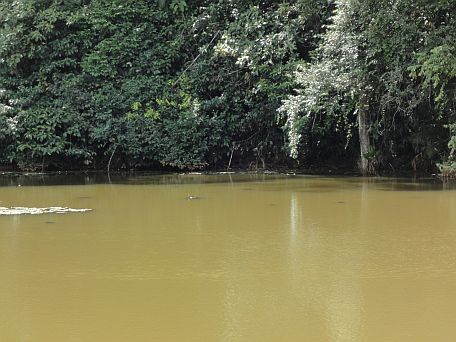
There is an Agami Heron somewhere in this image at the most reliable lodge to see it in Costa Rica- Laguna del Lagarto.
You could probably get the Agami from the lodge itself if you keep scanning for it as several of the rooms overlook the lagoon where we saw it. Speaking of the lodge, I was especially impressed with the excellent service and management provided by the manager, Alfaro. He took time out of his day to assure that each guest was getting the most out of his or her stay and kept us updated on where the Agami Heron had been sighted as well as other signature species such as Great Green Macaw. He also invited us to his “bird garden”- his very bird friendly backyard. We didn’t get the chance to visit it but from the photos of honeycreepers and tanagers that were taken at his garden, it should be a must see for any birder visiting Laguna del Lagarto with a camera.
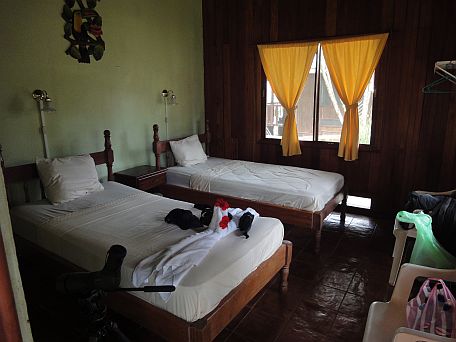
Rooms were comfortable and clean, the food average to good, and the feeders spectacular!
The feeders a Laguna del Lagarto consisted of a large bunch of bananas or plantains that are somehow placed on a platform twenty feet above the ground. BUT, since the dining area of the lodge is built on top of a hill, the birds that come to the feeder are seen at eye level! You almost feel as if you are sharing lunch with the toucans, parrots, oropendolas, and tanagers that visit the feeder because you can easily watch them sans binoculars while you eat.

A head-on view of a Chestnut-mandibled Toucan.

Keel-billed Toucans are incredibly colorful when seen at close range.

Collared Aracaris also partook in the feeder food but weren’t as common as their bigger bethren.
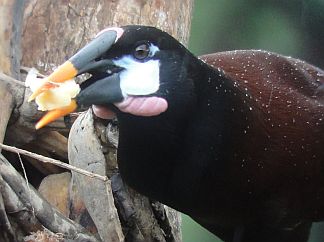
Montezuma Oropendolas also came close enough to allow detailed studies of their clown-like faces.
The best of the larger birds, however, were Brown-hooded Parrots. There aren’t many places where you can see these guys at a feeder!


Smaller species showed up once the larger birds left. Passerini’s Tanagers were of course very common.

Black-cheeked Woodpeckers were also present
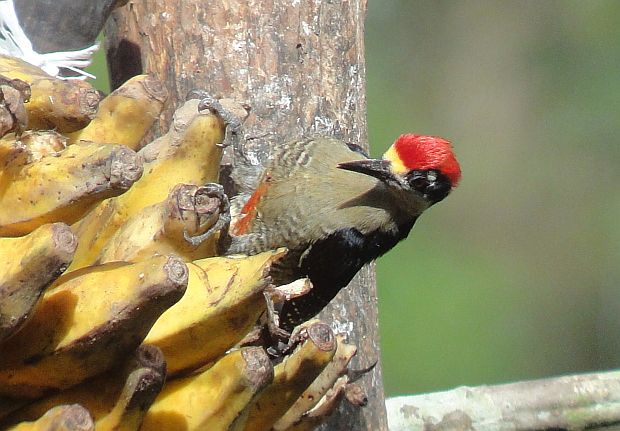
as were Buff-throated Saltators among a few other common species.

It was also worth it to scan forest canopy visible from the restaurant and some of the rooms. We had looks at Great Green Macaw and more than one perched King Vulture in this way.
Kind of distant for a photo but there’s no mistaking a white vulture with black flight feathers for anything other than a King.
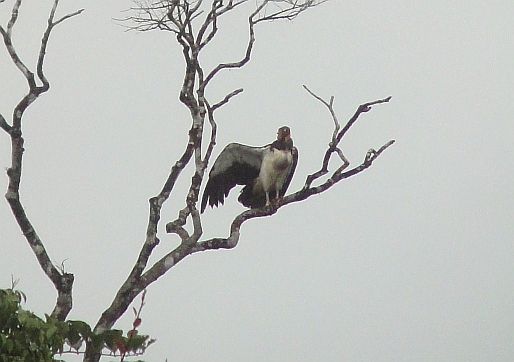
Laguna del Lagarto lodge also has trails through beautiful lowland rainforest. This type of habitat has become pretty hard to access on the Carbbean Slope so we were looking forward to spending quality birding time beneath the tall canopy. Most people experience it at La Selva but edge effects (and an overabundance of Collared Peccaries) have eliminated a number of understory bird species at that classic birding site. It was a shock, therefore, to see that a fair portion of Laguna’s forest looked as if it had been selectively logged! Apparently in 2010, a rare tornado had torn through parts of their forest and knocked over several, massive, old growth trees. It was a sad sight as we walked along muddy trails through open forest and I wondered why that tornado had to touch down at such a rare, complex, sensitive habitat instead of twirling around in some dusty, overgrazed pasture. There are still trails through intact forest at Laguna del Lagarto but I wonder if or to what extent the tornado affected bird populations. A local guide told us that canopy birds were easier to see but it looked as if understory species were less common and monkeys had certainly declined. Fortunately, the forest grows up pretty quick in the humid, rain-soaked lowlands so it will come back eventually.
During our three days at Laguna, our experiences in the forest echoed the sentiments of the guide. Canopy flocks were of regular occurrence but there were very few understory flocks and I heard very few understory species during our time there (even if you don’t run into mixed flocks of understory insectivores, you still usually detect them by sound), I have to believe that they are still around because the forest at Laguna is connected to a much larger forest block. I suspect, though, that they aren’t as common as they were in the past. Perhaps birds such as antwrens, spadebills, antvireos, and Tawny-crowned Greenlet will increase in abundance as the forest grows up. I certainly hope so but in the meantime, to see them at Laguna del Lagarto, you may need to focus on trails through more intact parts of the forest.
Some of the highlights of our stay at Laguna del Lagarto were:
Helping out with the annual Christmas Count (run by the Rainforest Biodiversity Group- the organization that created and promotes the Costa Rican Bird Route) while birding with David and Alfredo Segura. David is a young Tico birder, Alfredo his non-birding father. They make a great team and sharing much of Laguna’s birdlife with them was a memorable experience. Maybe I will interview them some day for the blog.
Agami Heron- Laguna is certainly the most reliable and accesible site for this species in Costa Rica.
Semiplumbeous Hawk- A scoped, calling individual deep inside the forest was a major highlight of the trip.
Great Green Macaw- This lodge and surroundings have long been known as a regular site for this endangered species. We saw maybe 7 individuals and had them on each of three days.
Brown-hooded Parrots at the feeders.
Mottled Owl seen at dawn on the road in front of the lodge. Black and white was also seen around the cabins by others and we heard but did not see Central American Pygmy-Owl.
Common Potoo- We didn’t see it but we did hear it and that earns it a position on my year list!
Pied Puffbird- We saw several of this cool, little bird.

White-fronted Nunbird- One of main targets fell on our last day at the forest edge in the back part of the garden and even allowed me to take its picture.

Thrushlike Schiffornis- We heard one of this deep forest species.
Brown-capped Tyrannulet- We had a few of these tiny, canopy flycatchers but they were always tough to see because of their size (or lack of).
Black-capped Pygmy-Tyrant- A common bird at Laguna del Lagarto and not to difficult to see with patience.
Yellow-margined Flycatcher- We had a few inside the forest with canopy flocks but they were very difficult to see well.
Slate-colored Grosbeak- Three birds seen together and one heard.
After leaving the lodge, we drove further up the road that follows the San Carlos River and although we saw little on a sunny afternoon, the whole area looks very promising. The road signed to the San Juan Biological Reserve in particular looked fantastic as it passed through intact, primary lowland rainforest but I am honestly concerned about the safety of birding it because you are in the middle of nowhere and close to the river that marks the border with Nicaragua (which may or may not be used by drug traffickers). That might sound paranoid but since a large amount of drugs are believed to pass through Costa Rica and the tendency for rural areas in the country to be quite lawless, it’s probably best to avoid birding along that road for the time being.

Fantastic road for birding but I don’t know how safe it is. I am sure it’s safe most of the time but it would be best to ask locals about it before birding there.
I would head back to Laguna del Lagarto Lodge or other lodges in the area in a second however, as they are safe, harbor some of the best lowland forests on the Caribbean Slope, and they probably hold some nice, feathered surprises too.
Below is a list of bird species we recorded from Pital to Laguna del Lagarto for the dates of January 7th, 8th, and 9th.
| Great Tinamou- a few heard and two seen |
| Little Tinamou- one heard |
| Neotropic Cormorant- one on San carlos River |
| Great Blue Heron- one at laguna |
| Great Egret- one along road |
| Snowy Egret- one on river |
| Little Blue Heron- one along road |
| Cattle Egret- several along road |
| Agami Heron- one seen along edge of lagoon, athers also saw from canoe |
| Green Ibis |
| Black Vulture- several |
| Turkey Vulture-several |
| King Vulture- 3-4 each day from lodge |
| Muscovy Duck- 2 along road |
| Osprey- one along road |
| Roadside Hawk- one along road |
| Broadwinged Hawk- one along road |
| Gray-headed Kite- one along road |
| Laughing Falcon- several along road and near lodge |
| Collared Forest-Falcon- 2 heard near lodge |
| Crested Caracara- a one along road |
| Semiplumbeous Hawk- 2 in forest |
| Gray Hawk- one along road |
| Crested Guan- a few in forest |
| Great Currasow- 1 heard, others saw a few at lodge |
| White-throated Crake- several heard along road |
| Gray-breasted Crake- one heard along road |
| Gray-necked Wood-Rail- one seen compost |
| Purple Gallinule- a few seen along road |
| Red-billed Pigeon- several along road |
| Short-billed Pigeon- several at lodge |
| Gray-chested Dove- a few at lodge |
| White-tiped Dove- one along road |
| Ruddy Ground-Dove- several along road |
| Olive-throated Parakeet- several |
| Orange-chinned Parakeet- just a few |
| Great Green Macaw- 6-7 at lodge |
| White-crowned Parrot- several |
| Brown-hooded Parrot-several at lodge and feeders |
| Red-lored Parrot-a few near lodge |
| Mealy Parrot- several at lodge |
| Groove-billed Ani- several along road |
| Mottled Owl- one seen |
| Central American Pygmy-Owl- a few heard at lodge |
| Common Pauraque- one along road |
| Common Potoo- one heard near lodge |
| Gray-rumped Swift- many |
| Long-billed Hermit- a few at lodge |
| Stripe-throated Hermit- a few at lodge |
| Scaly-breasted Hummingbird- a few along road |
| Purple-crowned Fairy- one in forest |
| Violet-headed Hummingbird- one in garden |
| Violet-crowned Woodnymph- a few in forest |
| Rufous-tailed Hummingbird- several |
| Bronze-tailed Plumeleteer- a few |
| Slaty-tailed Trogon- several heard in forest |
| Black-throated Trogon- one seen in forest |
| Broad-billed Motmot- a few heard |
| Ringed Kingfisher- a few near lodge |
| Green Kingfisher- a few on lagoons |
| Pied Puffbird- several in area |
| White-fronted Nunbird- 2 in back of garden |
| Collared Aracari- several in area |
| Keel-billed Toucan- several in area |
| Chestnut-mandibled Toucan- several in area |
| Black-cheeked Woodpecker- several |
| Smoky-brown Woodpecker- one along road |
| Lineated Woodpecker- a few along road |
| Pale-billed Woodpecker- a few in forest |
| Cinnamon Woodpecker- 2 heard near lodge |
| Slaty Spinetail- several heard along road |
| Plain-brown Woodcreeper- one heard |
| Cocoa Woodcreeper- a few heard |
| Streak-headed Woodcreeper- several |
| Black-striped Woodcreeper- several |
| Wedge-billed Woodcreeper- several |
| Northern Barred Woodcreeper- a few heard |
| Barred Antshrike- one heard along road |
| Western Slaty Antshrike- a few in forest |
| Dot-winged Antwren- a few near lodge |
| Chestnut-backd Antbird- a few in forest |
| Black-faced Anttthrush- several heard |
| Thicket Antpitta- one heard along road |
| Brown-capped Tyrannulet- several heard and a few seen at lodge |
| Yellow Tyrannulet- a few along road |
| Paltry Tyrannulet- several |
| Black-capped Pygmy-Tyrant- several |
| Common Tody-Flycatcher- a few heard |
| Yellow-olive Flycatcher- one heard at lodge |
| Yellow-margined Flycatcher- a few heard and seen in forest |
| Tropical Pewee- one heard along road |
| Yellow-bellied Flycatcher- several |
| Long-tailed Tyrant- a few along road |
| Rufous Mourner- one seen near lodge |
| Dusky-capped Flycatcher- a few heard |
| Great-crested Flycatcher- a few |
| Great Kiskadee- a few along road and at lodge |
| Boat-billed Flycatcher- two at lodge |
| Social Flycatcher- a few along road |
| White-ringed Flycatcher- one heard near lodge |
| TK- several |
| Thrushlike Schiffornis- one heard in forest |
| Red-capped Manakin- a few in forest |
| White-collared Manakin- a few along road |
| Black-crowned Tityra- one near lodge |
| Cinnamon Becard- several |
| Tawny-crowned Greenlet- a few heard in forest |
| Lesser Greenlet- many |
| Bay Wren- several heard |
| House Wren- several on road |
| White-breasted Wood-Wren- several in forest |
| Tropical Gnatcatcher- a few |
| Wood Thrush- several in forest |
| Clay-colored Robin- a few |
| Yellow Warbler- a few |
| Chestnut-sided Warbler- many |
| Hooded Warbler- one in forest |
| Northern Waterthrush- one at lagoon |
| Olive-crowned Yellowthroat- one near Boca Tapada |
| Gray-crowned Yellowthroat- one heard at river |
| Bananaquit- several |
| White-shouldered Tanager- several in forest |
| Tawny-crested Tanager- a few in forest |
| White-lined Tanager- one along road |
| Summer Tanager- several |
| Red-throated Ant-Tanager- one heard at lodge |
| Passerini’s Tanager- several |
| Blue-gray Tanager-several |
| Palm Tanager- several |
| Golden-hooded Tanager- several |
| Olive-backed Euphonia- several |
| Green Honeycreeper- a few |
| Shining Honeycreeper- several |
| Red-legged Honeycreeper- a few at lodge |
| Blue Dacnis- a few in forest |
| Scarlet-thighed Dacnis- one along road |
| Blue-black Grasquite- many |
| Variable Seedeeater- many along road |
| White-collared Seedeater- several along road |
| Thick-billed Seed-Finch- a few along road |
| Yelow-faced Grasquit- a few along road |
| Buff-throated Saltator- several |
| Black-headed Saltator- two along road |
| Slate-colored Grosbeak- three near lodge and one heard in forest |
| Orange-billed Sparrow- a few heard in forest |
| Black-faced Grosbeak- a few along road |
| Blue-black Grosbeak- several |
| Melodious Blackbird- a few along road |
| Red-winged Blackbird- a few along road |
| Bronzed Cowbird- a few along road |
| Baltimore Oriole- several |
| Scarlet-rumped Cacique- several in forest |
| Chestnut-headed Oropendola- a few in forest |
| Montezuma Oropendola- many |


















